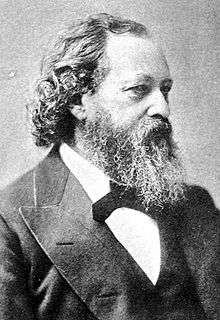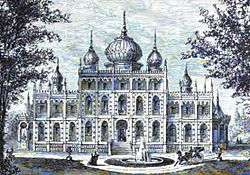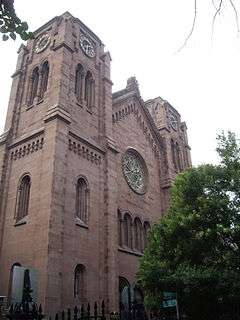Leopold Eidlitz

Leopold Eidlitz (March 10, 1823,[1] Prague, Bohemia – 1908, New York City) was a prominent New York architect best known for his work on the New York State Capitol (Albany, New York, 1876–1881), as well as "Iranistan" (1848), P. T. Barnum's house in Bridgeport, Connecticut; St. Peter's Church, on Westchester Avenue at St. Peter's Avenue in the Bronx (1853); the Brooklyn Academy of Music on Montague Street in Brooklyn (1861, destroyed by fire 1903); the former Temple Emanu-El (New York, 1866–68, destroyed 1927); the Broadway Tabernacle (1859, demolished about 1907); the completion of the Tweed Courthouse (1876–81); and the Park Presbyterian Chapel on West 86th Street and Amsterdam Avenue.[2]
Life and career
Eidlitz was born in Prague into a Jewish family; his parents were Abraham and Judith Eidlitz, and he had one brother Markus (later Marc) Eidlitz. He received his early technical training at the Prague Realschule and then continued his education at the Vienna Technical University. He enrolled in its short-lived business school, not its engineering or architecture curricula. Eidlitz emigrated from Vienna to the United States in 1843 and settled in New York. His brother Marc Eidlitz emigrated to New York three years later.[3]

Eidlitz spent three formative years in the office of Richard Upjohn. He likely participated in his project of constructing Trinity Church at the head of Wall Street, which was under way. He also worked with the architect Cyrus Lazelle Warner, whose office was a few doors from that of Upjohn's.[3]
In 1846 Eidlitz formed a partnership with the German immigrant architect Karl (now Charles) Otto Blesch, who had trained in Munich with Friedrich von Gärtner. One of their several joint commissions in New York was for St George's Episcopal Church (1846–49), still standing on the west side of Stuyvesant Square. Blesch designed the exterior, mixing Gothic and Romanesque styles,[4] and Eidlitz designed the plain interior and the original openwork spires.[5] The Episcopal congregation was so satisfied with the design that they rebuilt the church after a disastrous fire in 1865[6] following the same design, under Eidlitz' supervision.[7] By that time the design was also influenced by Dr. Stephen Tyng, a new pastor hired for what had become a changing urban congregation, in a neighborhood largely filled with immigrants. J.P. Morgan, still an influential parishioner, helped support many social services programs started by the church.
Eidlitz's reputation was marred by his involvement, with H. H. Richardson and Frederick Law Olmsted, in the re-design of the New York State Capitol in Albany. In 1875, Eidlitz, Richardson, and Olmsted proposed changes to the capitol, which was already under construction to designs by Thomas Fuller. In 1876 state officials dismissed Fuller and hired the trio, causing tremendous controversy. Eidlitz designed the capitol's Assembly Chamber and its now dismantled vault.
Eidlitz was a founding member of the American Institute of Architects in 1857.[8] In 1859, he joined the Century Association.
Writing on architecture
Eidlitz wrote numerous articles published in such journals as The Crayon in the 1850s and the American Architect and Building News beginning in the 1870s. He published a major book The Nature and Function of Art, More Especially of Architecture (New York and London, 1881), which proposed an organic theory of architecture that wedded German notions of art and science to American transcendentalist concerns.
Marriage and family
Eidlitz married Harriet Amanda Lazelle Warner in 1845. He had worked with her father Cyrus Lazelle Warner (1789–1852). Her mother was Elizabeth Wadland Adams (1792–1860), who, despite claims she made during her lifetime, was not descended from President John Adams. By means of this marriage Eidlitz helped secure his family's social place in the United States. Episcopal priest Stephen Tyng presided their wedding. They had seven children, but the first died soon after birth.[3]
Their eldest son, Cyrus Lazelle Warner Eidlitz (1853–1921), named after his maternal grandfather, also became an architect. Known as Cyrus L. W. Eidlitz, he designed the St. George Memorial House, part of the complex of buildings associated with St. George's on Stuyvesant Square. He went on to found the firm Eidlitz & McKenzie, designers of the original New York Times Building, One Times Square (1903–05).[9] On May 23, 1877, in the Church of the Ascension (Episcopal) in Buffalo, Cyrus Lazelle Warner Eidlitz married Jennie Turner Dudley (1854–1935), the daughter of Joseph Dana Dudley (1822–1880) and Caroline Felthousen Dudley (1835–1902). On her mother's side, Mrs. Dudley was a direct descendant of King Canute of Denmark (c. 985 or 995 – 1035), the last Viking to sit on the throne of England (1016–1035). Mr. Dudley was a descendant of both Thomas Dudley (1576–1653), of the Massachusetts Bay Corporation, and second governor of the Massachusetts Bay Colony; and Henry II of England (1133–1189) and Eleanor of Aquitaine (1122–1204).
Leopold's brother Marc Eidlitz was the founder of a major construction firm, Marc Eidlitz & Son Builders N.Y.C. in New York, which built the St. Regis Hotel and many other projects. Marc converted to Catholicism and kept close ties to the German immigrant community, becoming president of Germania Bank in 1888.[3]
Eidlitz has been called America's first Jewish architect. In his early work, as at the Shaaray Tefila synagogue, Eidlitz identified himself as Jewish to clients (1846–48). Other evidence suggests he later hid his heritage; his marriage was officiated by the Episcopal priest Tyng, and the Eidlitz children were raised as Christian, according to their mother's tradition. Eidlitz presented himself as simply German or Austrian and he Germanicized his parents' given names on American records. One of his daughters, Mari Imogene Eidlitz, was married in a Catholic ceremony in 1887 at St. Anne's Church in New York.[3]

See also
References
Notes
- ↑ Landmarks Preservation Commission: Tweed Copurthouse, 16 October 1984
- ↑ Park Presbyterian Chapel and Church have been the subject of a heated preservation battle in New York's Upper West Side. The main sanctuary, which occupies the corner lot, was added in a sympathetic style by Henry F. Kilburn (1889); Eidlitz had designed the first Park Presbyterian Church (West-Park Presbyterian Church (New York City)) at 84th Street and 11th (now West End) Avenue in 1854, when the Upper West Side was still suburban. (Christopher Gray, "Streetscapes: West-Park Presbyterian; An 1890 West Side Church Fighting Landmark Status", New York Times, January 10, 1988: accessed August 16, 2008).
- 1 2 3 4 5 Kathryn E. Holliday, Leopold Eidlitz: Architecture and Idealism in the Gilded Age. New York: W. W. Norton, 2008, pp. 29–30, 69
- ↑ Removal of the Gothic stone spires (1889) leaves the church more decidedly Romanesque; Romanesque was still an unfamiliar architectural vocabulary; the design was described as being in the "Byzantine or Early Christian style of architecture." (Kathleen Curran, "19th Century AD", The Art Bulletin December 1999 on-line text).
- ↑ Kathleen Curran, The Romanesque Revival 2003:267ff.
- ↑ Illustration of the church following the fire.
- ↑ New York City Landmarks Preservation Commission; Dolkart, Andrew S. (text); Postal, Matthew A. (text) (2009), Postal, Matthew A., ed., Guide to New York City Landmarks (4th ed.), New York: John Wiley & Sons, ISBN 978-0-470-28963-1, pp. 85–86
- ↑ AIA Historical Directory of American Architects http://communities.aia.org/sites/hdoaa/wiki/Wiki%20Pages/ahd1012417.aspx
- ↑ Library of Congress, American Memory, "Today in History: July 27" http://memory.loc.gov/ammem/today/jul27.html
Bibliography
- Holliday, Kathryn E. Leopold Eidlitz: Architecture and Idealism in the Gilded Age. New York: W. W. Norton, 2008.
- Schulyer, Mongomery, "A Great American Architect: Leopold Eidlitz," parts 1, 2, and 3. Architectural Record (September, October, and November 1908).
- Stern, Robert A. M.; Mellins, Thomas and Fishman, David. New York 1880: Architecture and Urbanism in the Gilded Age. New York: Monacelli Press, 1999.
-
 Wilson, James Grant; Fiske, John, eds. (1900). "Eidlitz, Leopold". Appletons' Cyclopædia of American Biography. New York: D. Appleton.
Wilson, James Grant; Fiske, John, eds. (1900). "Eidlitz, Leopold". Appletons' Cyclopædia of American Biography. New York: D. Appleton.
External links
| Wikimedia Commons has media related to Leopold Eidlitz. |
- ArchNewsNow at www.archnewsnow.com Restoration of Assembly Chamber at the New York State Capitol.
- Eidlitz, Leopold. "Competitions – The Vicissitudes of Architecture" Architectural Record (October–December 1894)